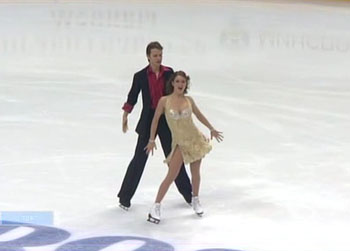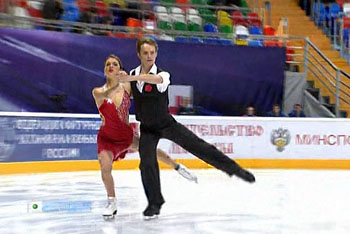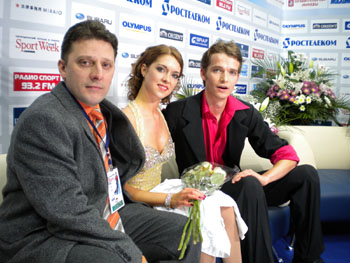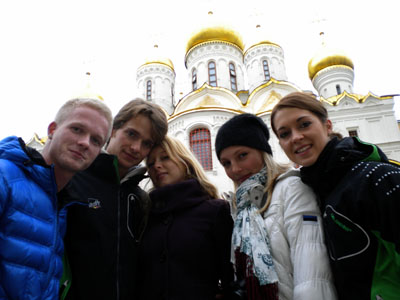Journal
November 2009
At the time of our last journal entry, we had to go through some uneasy days and nights. We didn't mention this in early October, but at that point we were already intensely contemplating returning to our old Free Dance. We got the idea during the analysis of the Nebelhorn Trophy, and we were discussing the pros and cons a lot. On the one hand, we wanted to stick to the new concept and not mess up our entire groundwork from the summer. On the other hand, we have important competitions very early this season where it counts to show a good performance.
We decided to skate our old Free Dance again, and the crucial argument can basically be described in terms of the economy. Basically, all the investments we put into the Free Dance over the summer are irrelevant for the decision (sunk costs). The choice for the alternative that leads to a better output, which was the old Free Dance in our case, is hereby independent of previous investments. Spontaneously, we went to Munich to revive the old choreography and to integrate some passages from the new into the old Free Dance. We were supported by Mr. Skotnicky, who, together with ballet mistress Ms. König, put a lot of effort into the old/new program.

It was our wish and that of our coaches that we'd skate the Free Dance in new costumes. However, we needed them within approx. 1.5 weeks in order to skate in them at least once before the Grand Prix in Moscow. Actually, we were hoping for some financial aid from the German Skating Union to have these costumes made, but we had already maxed out our budget for this year with all the other costumes. In addition, the lack of time prevented us from having them made by our usual seamstress in Prague. Therefore we decided in favor of a seamstress in Bonn who costs considerably more than we normally pay. When our grandparents picked up the costumes at 5 o'clock on Tuesday, we wore them on the ice one last time before we flew to Moscow on Wednesday.
On Daniel's birthday, shortly before we went to Moscow, Mr. Skotnicky came to Dortmund to work on the Tango with us because we had neglected this dance a bit after the Nebelhorn Trophy. Luckily, it was fall vacation in NRW at that time, which means we could make use of additional ice time. On some days, we spent a good 6 hours on the ice and flopped tired into bed at night. It often happens that you're still thinking about corrections from practice when you're in bed, and then you're looking forward to the next day when you finally get a chance to do better again.
Despite the failure, our motivation was incredibly high, and we were downright excited about the competition in Moscow. In general, the Top 30 teams of the past season get invited to the Grand Prix series, and so we knew that we'd be facing a tough competition. Our goal was to clearly meet the Olympic standard and maybe even to defeat another team.
The competition in Moscow was very well-organized and was conducted professionally. Our hotel was only about 15 min away from the rink by foot, and it was roughly 10 minutes by metro to Red Square. Red Square, which both of us imagined as really being red, isn't red, but gray. Only some buildings around the square are red. The name is derived from the adjective (krasny), which originally meant "beautiful," but in the course of time the meaning changed to "red."

We were already a bit surprised about the very low score we received for the Compulsory Dance. We received round about one point less than in Oberstdorf even though we skated better. However, when we spoke to other teams who had competed in Oberstdorf, too (half the competition had already competed against each other in Oberstdorf), they told us that they had up to 3 points less and blamed this on the generally higher level at a Grand Prix. When we received considerably lower components in the OD, we were again very surprised and also disappointed because it began to show that we wouldn't stand a chance here, either, to reach the required 145 points. Correspondingly, we skated the Free Dance more relaxed, and in the end we were happy about the very good levels that we received. Except for the steps, all the elements were rated as the highest level of difficulty, level 4. In the diagonal step sequence, we received a good level 3, and in the circular step sequence, due to Carolina's fall, only a level 1. The technical score therefore wasn't bad at all despite the fall, only the components left room for more. We'd be lying if we said that we weren't disappointed. Up until today, we're still not quite sure why we received such low scores. After the competition, we were attested that we had been working well since the Nebelhorn Trophy and that we should definitely continue that way.

We were aware that it would be a close thing with the Olympic standard, but we still had two competitions on our schedule for which we considered having a realistic chance of making it. When the news reached us that we were invited to the Grand Prix event in Canada, we were very happy. Later, however, we realized that this event would be at the same time as our competition in Olomouc. This means that we're losing an important opportunity for meeting the Olympic standard. As you have seen with the results from Paris, Moscow, and Beijing, the scoring is stricter at a Grand Prix in comparison to other competitions.
Since October 1, Daniel has been with the German Armed Forces, too, and he serves his basic military training there.
As far as our mother is concerned, there was a report about her and our three youngest siblings on German TV (channel NDR) in mid-October. It was about her life on Rügen and described our family a little. Under the title "Seven Children, 40 Horses: the Horse Farm Viervitz," you could get a good insight into what it's like to be a "Hermann."
As difficult as it got in the last few days, it's now time for us to not bury our heads in the sand and to carry on.
Best wishes,
Carolina and Daniel

|

